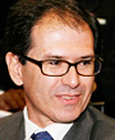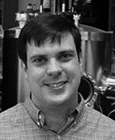| |
|



































|
| PANELISTS |
| |

 |
| ANDRÉ AYRAL |
| Institut Européen des Membranes. France |
| Advances in ceramic materials engineering enable the development of membranes exhibiting high thermal, mechanical and chemical stability, with tailored microstructure and porosity, with possible complex shapes and coupled functionalities like catalytic activity. Multifunctional ceramic membranes for water reuse are open investigation topics for basic and applied research projects. Direct coupling of membrane separation and advanced oxidation processes like heterogeneous catalytic ozonation or photocatalysis is a promising domain for integrated processes of water treatment. |
|
|
 |

 |
| DANIEL BAR |
| VP, General Manager of Ameridia. USA |
| Over the last years, Eurodia Industrie has developed new types of electrodialysis (ED) stacks to achieve high one-pass desalination rates of up to 80 % and allow for very compact systems. These systems are very well suited to process brackish waters with low salt levels (between 1 and 5 g/l). These compact ED systems can also easily be paired with reverse osmosis units to increase the water recovery rate from ~75% to 95%. In addition, Eurodia is very interested in the Capacitive Deionization (CDI) Technology, because of the great process simplifications that can be achieved, still with high recovery rates (90% with desalination rates of up to 90%). To develop applications for CDI, Eurodia is working in partnership with Enpar Technologies (Guelph, Ontario, Canada). Overall, the main objective of Eurodia for water treatment applications is to develop small, compact, and simple units, consuming low energy (potentially powered by solar energy), and that can be installed in batteries for larger capacities. |
|
|
 |

 |
| MIHAIL D. BARBOIU, PhD |
| Institut Européen des Membranes. France |
| Numerous artificial transport systems utilizing carriers, channel-forming or self-organized polymeric superstructures able to orient, to select and to pump the ionic transport across membranes have been developed in the last decades. Of special interest is the structure-directed function of hybrid membrane materials and control of their build-up from suitable units by self-organisation. The main interest focus on functional hybrid membranes in which the recognition-driven transport properties could be ensured by a well-defined incorporation of receptors of specific molecular recognition and self-organization functions, incorporated in a hybrid dense materials. We are therefore proposing to review the membrane transport properties of such supramolecular membrane materials with potential in renewable energy applications as fuell-cells technology, biomimetic water and ion channels, etc. |
|
|
 |

 |
| BRUCE BISHOP |
| VP & General Manager, CeraMem® Ceramic Membrane Systems-Veolia Water. USA |
| Ceramic membranes are a key tool in the treatment of a variety of industrial process and waste waters. Over the last several years, large format ceramic membranes are starting to gain a foothold in industrial applications. CeraMem™ ceramic membranes were the forerunner for all large format ceramic membranes and are now offered commercially by Veolia Water Solutions & Technologies. Further, CeraMem was the first to offer both metal oxide-based and SiC-based elements. Large format ceramic membranes are expanding the applications for ceramic membranes. These include high flow produced water treatment with and without downstream unit operations. This presentation will provide a snapshot of ceramic membranes for industrial separations and examples of new applications for their use. |
|
|
 |

 |
| PROF. STEPHAN BROSILLON |
| University of Montpellier. France |
| The raw water and waste water can contain emerging substances (i.e : endocrine disruptor; drugs, pesticides,...) that are present at very low concentrations . To treat water, the membrane separation is a very powerful operation to get very high quality of water. However some molecules can be present in the permeate or concentrated in the retentate. The hybrid process: advanced oxidation/membrane allows facing these situations and ameliorating the overall quality of water fluxes |
|
|
 |

 |
| HERVÉ BUISSON |
| VP of Technologies for Veolia Water - Solutions and Technologies, North America. USA |
| Membranes and membrane processes have had a profound impact on the water industry over the past 50 years. Market drivers and technology progress are evolving at a very fast pace, putting more emphasis on energy consumption and environmental foot print on one hand, while providing novel materials with much improved performances on the other hand. These forces are paving the way for a new generation of membrane processes, as illustrated by recent projects in Veolia. |
|
|
 |

 |
| PROF. CORINNE CABASSUD |
| Chemical and Environmental Engineering at INSA. France |
| Membrane distillation is an hybrid membrane-evaporative process that is based on the use of hydrophobic porous membranes that are a support for the liquid/vapor interface. Some specific membranes and large scale modules are under development and being tested on site by different companies. The lecture will introduce recent results that show the potential interest of MD for desalination of sea water and mainly for the over-concentration of brines in desalination treatment lines. A focus will also be given to the removal of arsenic which is becoming a key sanitary problem in some developing countries. The interest of coupling MD with renewable energy systems will be discussed. Perspectives and opportunities for further collaborative researchs will be introduced. |
|
|
 |

 |
| PROF. JOAO CRESPO |
| Chemical Engineering/Vice rector of the Universidade Nova de Lisboa. Portugal |
This lecture will discuss membrane bioreactors as a way of organizing the physical space for transport of target solutes (contaminants) and their bioconversion in catalytic compartments. A particular emphasis will be given to the removal and bioconversion of micropollutants and the on-line, real-time monitoring of membrane bioreactors. |
|
|
 |

 |
| DIDIER DHALER, PhD |
| Chief Technology Officer-Membrane Technologies, CTI. France |
| |
|
|
 |

 |
| PROF. GÉRAUD DUBOIS |
| Manager Hybrid Polymeric Materials at IBM. USA |
| The global water crisis and the growing demand for fresh water have spurred enormous interest in energy efficient technologies to produce safe drinking water from the ocean. IBM and KACST have partnered to build in Saudi Arabia the first of a kind desalination plant powered by solar energy. To achieve this goal, they have combined ultra-high concentrator photovoltaic (UHCPV) technology with energy efficient reverse osmosis membranes. IBM has drawn inspiration from the chemistry used in low dielectric constant materials and in designing top-coats for 193nm water immersion lithography to develop two generations of new polyamide thin film composite reverse osmosis membranes. The performance of these membranes compared to commercially available ones and the current status of the project with KACST will also be discussed. |
|
|
 |

 |
| JEAN-MICHEL ESPENAN, PhD |
| Founder and Principal Owner of Polymem SA, Toulouse. France |
The presentation will show how the ultrafiltration on porous hollow fiber membranes has gained more and more attention since the late eighties when it starts up to now worldwide: After the production of drinking water from source water , it is now widely applied as the generic filtration step in the production of drinking water from surface water and seawater, the treatment and the reuse of industrial and municipal process water and wastewater.
A standardisation of the membranes and modules has not come leaving a large room yet to Innovation. Polymem is present in this innovation with New Module Configuration (Gigamem R) and New Membrane Material (Neophil).
Polymem will present the Cluster WSM (for Water Sensors and Membranes), a new funded association gathering universities and companies in the area of Toulouse where hollow fibers for water filtration are manufactured since 1986 and where a great potential in R and D exists in both the Membranes and the Sensors for water treatment. |
|
|
 |

 |
| PROF. BENNY D. FREEMAN |
| Kenneth A. Kobe Professor in Chemical Engineering at The University of Texas in Austin. USA |
| Polymer membranes have emerged as a leading technology to desalination water (reverse osmosis and nanofiltration) and are being explored for energy generation in applications such as reverse electrodialysis and pressure retarded osmosis. This presentation focuses on the fundamentals of ion and water transport in polymers. Structure/property correlations are shown for a variety of polymers, including uncharged and charged materials. |
|
|
 |

 |
| CHRISTIAN GUIZARD, PhD |
| Research Director at CNRS. Saint Gobain. France |
| The surface properties of silicon carbide (SiC) actually differ from those of metal oxide ceramic materials. This can explain the specific behavior of SiC membrane compared to ceramic oxide membranes in water filtration, in particular the higher flux and the less fouling tendency of the former one. Moreover SiC provides unique properties such as high thermal conductivity, thermal shock resistance, biocompatibility, resistance in acidic and alkali environments, chemical inertness and high mechanical strength which make it a promising candidate material for a variety of inorganic membrane applications. Accordingly, Saint-Gobain is developing pure α-SiC microfilters with a module design well adapted to the implementation of very compact filtration plants. A brief survey will be given of the characteristics of these microfilters. |
|
|
 |

 |
| PROF. JONGYOON HAN |
| Associate Professor, Department of Electrical Engineering and Computer Science and the Department of Biological Engineering, MIT |
| Even though the energy efficiency of Reverse Osmosis (RO) plants improves toward the theoretical lower limit, desalination of water remains energy- and infrastructure-intensive endeavor. For many applications, scalable, grid-independent (self-powered), and distributed (on-site) water production model is better suited than traditional infrastructure-scale water generation and delivery. While RO technology is not scalable, electrochemical desalination technologies can be implemented in a scalable manner but their poor energy efficiency in general has been limiting wide adoption in water industry. Recently, we developed a novel electrochemical desalination technology based on Ion Concentration Polarization (ICP) phenomenon, whose preliminary data suggests that it can provide high energy efficiency of RO in a scalable manner. In addition, recent effort at Siemens Water also signifies the potential merit of electrodialysis (ED) as a future scalable desalination technology. |
|
|
 |

 |
| PROF. BRUCE HINDS |
| William Bryan Professor of Materials Engineering Dept. of Chemical & Materials Engineering, University of Kentucky Lexington, KY. USA |
| Carbon nanotubes (CNT) have three key attributes that make them of great interest for novel membrane applications 1) atomically flat graphite surface allows for ideal fluid slip boundary conditions for 10,000 fold faster fluid flow 2) the cutting process to open CNTs inherently places functional chemistry at CNT core entrance for gatekeeper activity and 3) CNT are electrically conductive allowing for electrochemical reactions and application of electric fields gradients at CNT tips. These unique properties allow us to explore the hypothesis of producing ‘Gatekeeper’ membranes that mimic natural protein channels, including the water channel aquaporin. CNT support single-file water transport at high rates for desalination applications. In addition, the conductive nature of CNTs allows for electrochemical de-fouling by the generation of nanobubbles or ionic brush pumps. |
|
|
 |

 |
| PROF. ERICK M.V. HOEK |
| University of California, Los Angeles
Department of Civil & Environmental Engineering
and California NanoSystems Institute
|
| In the past decade, many exciting and new advanced materials concepts have been proposed for synthesizing better performing water desalination and filtration membranes. These concepts include aquaporin protein-based biomimetic membranes, aligned-carbon nanotubes, zeolite-coated ceramic membranes, zeolite-polyamide thin film nanocomposites, and “chlorine-tolerant” sulfonated or fluorinated polymers among others. Most of these innovations have been motivated by the creation of “high flux” RO membranes; however, the energy, environmental and economic drivers for most RO desalination applications are not constrained by flux, but rather by osmotic and hydraulic losses as well as fouling and scaling limitations. A few innovative research efforts have targeted fouling-resistant, scaling-resistant and chlorine-tolerant RO membranes. The talk will briefly introduce some of these concepts, including thin film nanocomposite (TFN) membranes, which are now produced and sold commercially by NanoH2O Inc. The discussion will include examples from the literature and our own research targeting membranes with improved chemical, mechanical, and thermal stabilities, as well as membranes with improved selectivity, anti-fouling, and self-cleaning interfaces. |
|
|
 |

 |
| PROF. RICHARD NOBLE |
| Alfred T. & Betty E. Look Professor; NSF Industry/University Cooperative Research Center for Membrane Applied Science and Technology, Co-Director. USA |
| A non-aqueous, type I bicontinuous cubic (QI) lyotropic liquid crystal (LLC) monomer system based on a new gemini imidazolium monomer with glycerol has been developed that allows facile solution processing to yield unprecedented thin-film composite (TFC) LLC membranes with 3D-interconnected molecular-size pores. The cross-linked TFC QI membranes have a ca. 3-µm-thick active top layer with uniform, 0.96-nm-wide, cationic annulus pores that enable size sieving of neutral solute molecules from water. They can also reject smaller hydrated salt ions (0.72–0.86 nm) near or at the level of reverse osmosis (RO) membranes (>98%) due to additional pore–metal ion cationic repulsive interactions. This new material has a thickness-normalized pure water permeability ((6.6 ± 0.5) x 10–2 L m–2 h–1 bar–1 µm) that is comparable to active layer materials in current TFC RO membranes. |
|
|
 |

 |
| PROF. VLAD TARABARA |
| Associate Professor of Environmental Engineering at Michigan State University. USA |
| Polymer nanocomposites filled with hierarchical functional nanostructures are proposed as a materials framework for the design of multifunctional membranes. The structure and reactivity of such membranes can be independently controlled by regulating the relative content of components representing different levels in the nanofiller hierarchy. The resulting composites are shown to be catalytically active membranes that are more resistant to compaction, more permeable than filler-free membranes and at least as selective. |
|
|
 |

 |
| JEAN MARC PANDRAUD |
| President & CEO, Clean Membranes Inc. |
| Moderator of the workshop 3. |
|
|
 |
 |
| |
|
|
|


